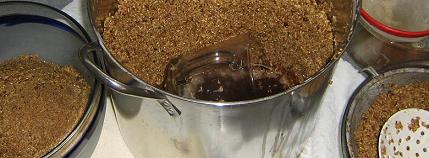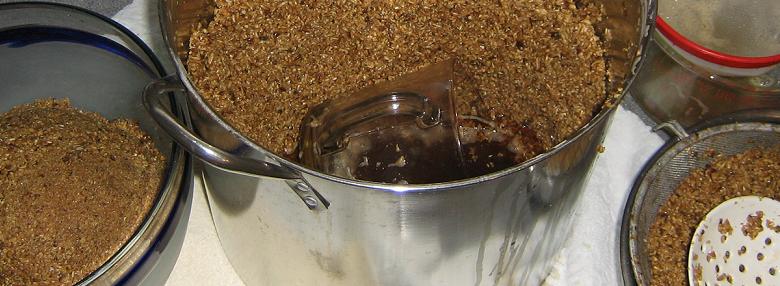Shot Put 2008: Day one, May 11. Much sadness as a bunch of 22s and a 23 was all there was. Kids did better with a 18 and a 10 on the 2 kg respectively.
Death On Yonge Street
A sad view out of the front window driving up Yonge Street Toronto this noon hour. Is there anything sadder than a big outdoor video screen that has been turned off? That wasn’t in Blade Runner. Maybe the spinning LP neon signs that are either gone or busted. Oh for a barn that had the interior room for a more dignified retirement for one of those flashing 33 rpm beauties.
Mucho Big Doings At Ontario’s Church-Key Brewing
 I was going to call this post “John Graham – He Cleans Up Pretty” but that might have been the right one had I not been the last to know just about everything going on at Church-Key Brewing in the rolling Northumberland Hills about an hour and a half to my west. See…he cleaned up that pretty ten months ago – though to be fair, I can’t be certain there’s a tie under all that beard.
I was going to call this post “John Graham – He Cleans Up Pretty” but that might have been the right one had I not been the last to know just about everything going on at Church-Key Brewing in the rolling Northumberland Hills about an hour and a half to my west. See…he cleaned up that pretty ten months ago – though to be fair, I can’t be certain there’s a tie under all that beard.
I dropped in today on my way back from Toronto where I gave a speech this morning. I have been popping in when coming heading home when traveling. Things look good, I think as I turn into the repurposed rural church parking lot. I walk towards the front door of the church when I realize there is a door at the other end of the building with a sign that says “Beer Store”. [This being eastern Ontario, I really think he should put up “In And Out Store” so people would really understand.] I said to the clerk “new store, eh?” to which I received a “yes, sort of…I guess.” I popped back into the brewery to see John and have a chat as he cleaned out a filter and when I mentioned the new shop he just “how long since you were in?” as he handed me a taste of the IPA he was making.
Too long as it turns out. Too long to know that they sell growlers of their excellent beer. [May I have a woot?] Too long to know he is bottling his special Heavy Weight Series in bombers – I picked up three including his Flemish sour. I had though they were all getting casked for the bar trade. Heck, you can buy some swag for yourself at the brewery’s on-line retail shop. And when I got home to look up something I wasn’t paying attention long enough to realize that last April John was nominated to run as a Federal Green Party candidate in the next election:
John provides a working example of how to maintain a healthy balance between environmentalism and entrepreneurship. As founder and President of Church-Key Brewing Company, John walks the talk in both his business and personal life. At Northumberland County’s only craft brewery, John puts his philosophies into action. Technologies such as solar hot water, bio-diesel, radiant floor heating, Bullfrog Power, and heat recovery units not only lower the carbon output of the award-winning brewery, they also improve the bottom line.
Hmmm – a small brewer controlling cost inputs though taking on responsibility for more aspects of their own operation. Who would have thought it was possible? I have got to stop by more often.
Sour Beer Studies: Gueuze, Girardin, Sint-Ulkis-Kapelle, BE
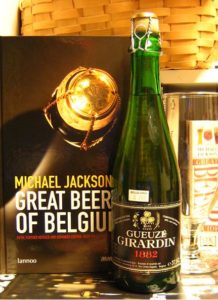 The 2006 edition of Great Beers of Belgium showed up today and I thought that I had better pop a cork in its honour. A Girardin Gueuze seemed just the thing. The “1882” on the label is the date when the current family took over the brewery and they brew comprehensively, perhaps still with no other staff. Jackson noted:
The 2006 edition of Great Beers of Belgium showed up today and I thought that I had better pop a cork in its honour. A Girardin Gueuze seemed just the thing. The “1882” on the label is the date when the current family took over the brewery and they brew comprehensively, perhaps still with no other staff. Jackson noted:
They grow their own wheat, brew Lambic in winter and produce a Pils in summer. The Girardins use 40 per cent wheat in their Lanic, and still have a mill that grinds the grain between stones, as well as a more modern one with metal cylinders. “We continue to use the stones for some of the grist,” Lousi told me, “in case it contributes to the character of the beer.”
I like that “in case” a fine expression of traditional conservatism. Jackson called it one of the most complex beers he had ever tasted. The black label (or in Flemish Zwart etiket) appears to indicate unfiltered [Ed.: ie fond] while a white label (or Wit etiket) would not [Ed.: ie filtré]…though neither Ed nor I quite know why “etiket” in Flemish means “label” in English. I bet Ron knows.
On the pour, the funk jumps out of the madly growing off white head that soon fall back at a leisure pace. Barnyard. Very evocative of poo and stall of a former neighbour’s beef cattle barn. Plus rice wine vinegar as well as Gravenstein apple. But it is all wrapped around a small core of sweet. Once in the mouth, the barnyard knows and takes its place letting other flavours come forward. Overall, this is a far less austere Lambic experience compared to the stridency of Cantillon, even their gueuze. Relatively (by which I mean relatively) soft as well as acidic – an odd combination to describe but think mandarine orange juice without any orange flavour and a good slug of rice wine vinegar. Plenty of grain, a little lemon and a lot white grapefruit citrus, a little wheat cream even. Grassiness in the middle which morphs a little into something that is like a hint of licorice. Dry and acid and moreish in the finish. Fabulous. Love it. I am going to buy this beer whenever I see it. I promise me so.
Plenty of BAer love. $7.99 for 37.5 cl from Bello Vino in Ann Arbor Michigan.
A Bad Brewer Asks: “What The Heck Is That I Made??”
I am a bad brewer. I think it’s important to brew to make sure you have a hand on the paddle, a sense of what yeast might actually expect from you. That being said, though people have admired my beer greatly, I know the truth. I’m a bad brewer. It has a lot to do with the effort I put in compared to the output I get. I brewed from five to eleven last night to make a pre-boil 16 litres. Subtract from that some for evaporation, for trub, for that last bit the hose won’t reach, for the unintentional spilling while filling and all the other sources of wort loss. I’ll be lucky to end up with 12 litres. And look at that photo – what sort of technique is that supposed to be?
Not that this was unintentional. No, back in 2002 or so, I used to brew in a sort of parti-gyle way making multiple runnings that are later added back together again with a further gravity adjustment, making a strong syrup and cutting it with sterile water before the fermentation stage. That got me up to 40 litres per brewing session. That mean around 50 bottles and a keg. It also meant way to much drinking beer at hand even with those new friends that suddenly identify themselves to the home brewer. I’ll be doing sit-ups until about 2011 to make up for that little error in judgment. Funny how I realized almost immediately that the skills I had gained to make my first four pound batch of the best cream cheese you’ll ever eat were going to be my downfall. I ended my cheese making career there and then. But I have brewed badly for years, off and on.

Update: 6:00 pm, Wednesday. It is churning now! Given the rate of activity, the dry yeast was likely unnecessary but never a bad call to be safe and kick start the batch.
A Bad Brewer Asks: “What The Heck Is That I Made??”
I am a bad brewer. I think it’s important to brew to make sure you have a hand on the paddle, a sense of what yeast might actually expect from you. That being said, though people have admired my beer greatly, I know the truth. I’m a bad brewer. It has a lot to do with the effort I put in compared to the output I get. I brewed from five to eleven last night to make a pre-boil 16 litres. Subtract from that some for evaporation, for trub, for that last bit the hose won’t reach, for the unintentional spilling while filling and all the other sources of wort loss. I’ll be lucky to end up with 12 litres. And look at that photo – what sort of technique is that suppose?
Not that this was unintentional. No, back in 2002 or so, I used to brew in a sort of parti-gyle way making multiple runnings that are later added back together again with a further gravity adjustment, making a strong syrup and cutting it with sterile water before the fermentation stage. That got me up to 40 litres per brewing session. That mean around 50 bottles and a keg. It also meant way to much drinking beer at hand even with those new friends that suddenly identify themselves to the home brewer. I’ll be doing sit-ups until about 2011 to make up for that little error in judgment. 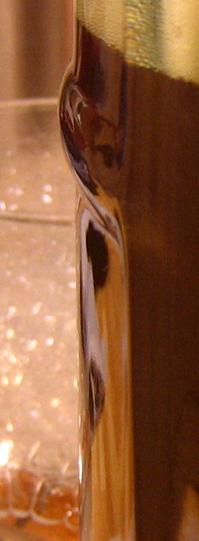 Funny how I realized almost immediately that the skills I had gained to make my first four pound batch of the best cream cheese you’ll ever eat were going to be my downfall. I ended my cheese making career there and then. But I have brewed badly for yeast, off and on.
Funny how I realized almost immediately that the skills I had gained to make my first four pound batch of the best cream cheese you’ll ever eat were going to be my downfall. I ended my cheese making career there and then. But I have brewed badly for yeast, off and on.
But what sort of 16…err, 12 litres of beer do I have. I started with an all grain ESB kit, brewed it a bit thick so that it came away with an OG of 1.055 rather than my usual 1.040 or so. And I threw in 350% of the suggested hops plus two star anise pods as well as 1/8th of a cup of molasses and then pitched Wyeast 1968 London ESB yeast. I think this might turn out to be Crazy Old Man Ale. Maybe it’ll turn out great, if the fermentation ever actually begins. Hopefully by Thursday morning, I’ll be watching a fierce roaring mass of yeast farts through the carboy’s glass wall giving off the first scents and sense of what the heck is growing in there.
Update: 6:00 pm, Wednesday. It is churning now! Given the rate of activity, the dry yeast was likely unnecessary but never a bad call to be safe and kick start the batch.
My Deep And Witty Analysis Of The Big Hop Giveaway!
My computer ate it. It was a virtual unified theory of beer blogging, an apology draped in an accusation resting on a question with its feet up on satisfaction. Brilliant. Gone. In sum: I didn’t like their variety packs, the special glass, Utopia, the ’90’s triple bock or their white-like thing; but, once called out, I found liked their value-priced Scotch Ale and premium Imperial pilsner a lot and the ads have grown on me; remember that good business knows it does one good to do good; remember, too, they are a big raft brewer with a range from perhaps some kraphtt, much craft, and some special; I have no idea what percentage of their total hops ordered this giveaway of allotment represents; but in the end it is great to see a breakaway brewery remember that a rising tide raises all boats. Good work, Jim.
The long version was better. An epic.
Stouts: Choklat, Imperial Stout, Southern Tier, New York
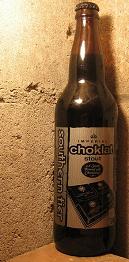 Chok-o-la-da. That is how we say it in our house because we met in Poland back in 1991. Gdansk was a hot bed of decent chocolate that was sold for pennies a bar around the Baltic shore towns like the one where we lived. Other than that, I am fairly indifferent to the stuff.
Chok-o-la-da. That is how we say it in our house because we met in Poland back in 1991. Gdansk was a hot bed of decent chocolate that was sold for pennies a bar around the Baltic shore towns like the one where we lived. Other than that, I am fairly indifferent to the stuff.
On the nose, is/are there Goldings? Definitely a big cream yeastiness and, yes, dark chocolate. Not cocoa and not milk chocolate. You might even say it’s 75% dark chocolate but that would be pushing my luck. In the mouth, well, it is thick. No other word for it. There is bitter from hop in there, too, replicating good dark chocolate. Yet there is also texture of malt graininess as well as the richness of chocolate malt and a bit of licorice in the finish. Not like chocolate syrup with alcohol added. Quite a thing. Quite an amazing 11% thing.
Once again, Southern Tier is batting 1.000 as far as I am concerned. Huge BAer support.


